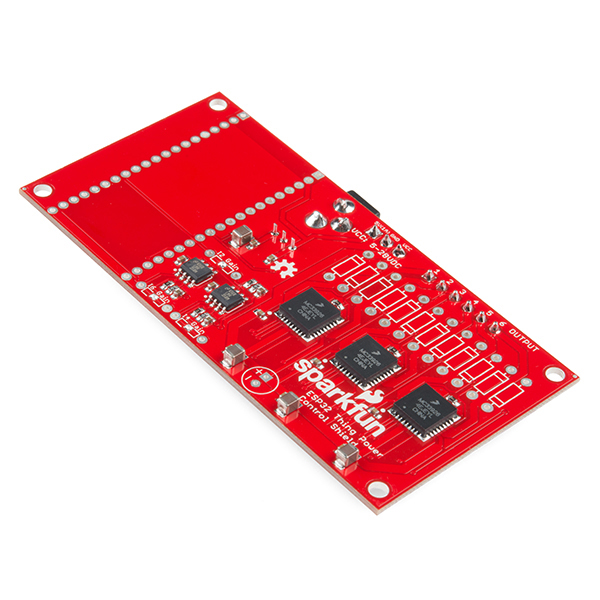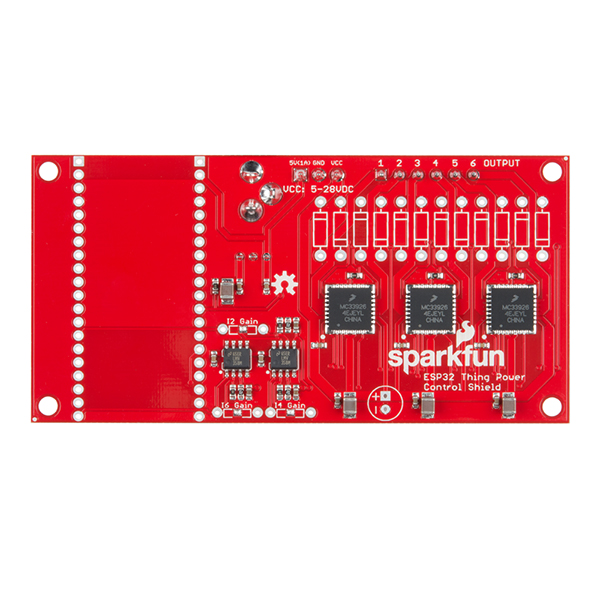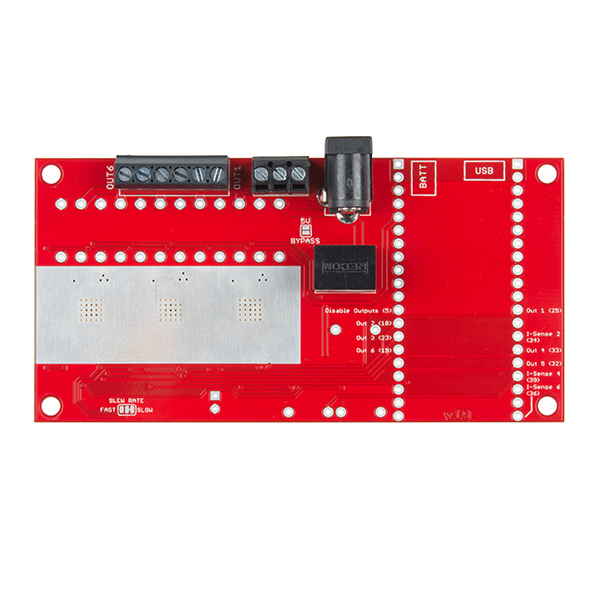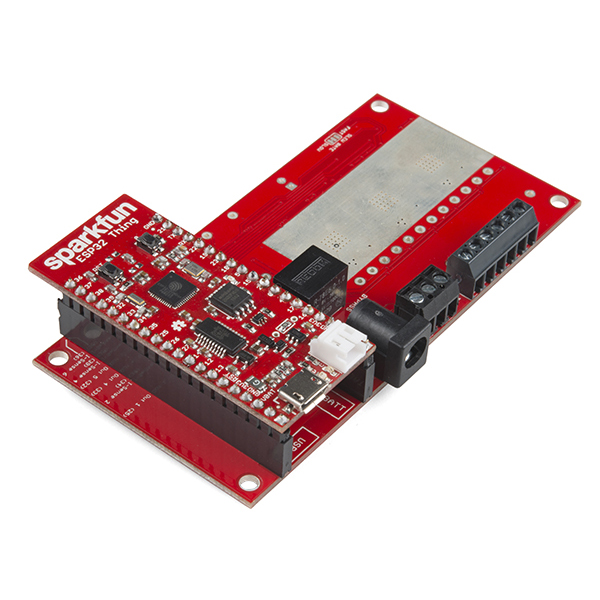SparkFun ESP32 Thing Power Control Shield
The SparkFun ESP32 Thing Power Control Shield enables the ESP32 Thing to switch up to 5A of a DC load, providing a wide variety of options to control your next project! With a default voltage range of 5--28VDC, power can be connected to this shield in one of two ways. The first is the barrel connector, but with a maximum current rating of 2.5A (designed for light loads). The second option is on the 3-pin screw terminal, which has connections for VCC, ground and a 5V output. The supply voltage is regulated down to 5V to power the ESP32 Thing, as well as a fan to keep the board cool under heavy loads.
At the heart of the board are three MC33926 motor drivers by NXP Semiconductors. While the board is theoretically capable of switching up to 30A total, the power traces in the board and connectors have only been tested up to 10A total across the six output pins. Along with switching DC loads on and off, the MC33926 has three built-in current sensors, which are connected to output pins 2, 4 and 6. Each of the current sensors is connected to an LMV358 operational amplifier to adjust the gain of each current measurement.
Due to a drawback with the MC33926 only possessing one current sensor per driver, we've added a feature to the Power Control Shield for loads smaller than 5A. For smaller loads, clearing the solder jumper and soldering in the appropriate feedback resistors can maximize the sensitivity of the 12-bit analog-to-digital converter (ADC) built into the ESP32 Thing. We have a full table written in our Hookup Guide below.
Note: This product only includes the SparkFun ESP32 Thing Power Control Shield. The ESP32 Thing, headers and optional thermal gap filler will need to be purchased separately.
- Schematic
- Eagle Files
- Hookup Guide
- Datasheet (MC33926)
- GitHub
SparkFun ESP32 Thing Power Control Shield Product Help and Resources
ESP32 Thing Power Control Shield Hookup Guide
June 9, 2017
This tutorial shows you how to get started with the ESP32 Thing Power Control Shield.
Using Home Assistant to Expand Your Home Automations
May 9, 2019
An introduction to Home Assistant, an open source home automation hub.
Core Skill: Soldering
This skill defines how difficult the soldering is on a particular product. It might be a couple simple solder joints, or require special reflow tools.
Skill Level: Noob - Some basic soldering is required, but it is limited to a just a few pins, basic through-hole soldering, and couple (if any) polarized components. A basic soldering iron is all you should need.
See all skill levels
Core Skill: DIY
Whether it's for assembling a kit, hacking an enclosure, or creating your own parts; the DIY skill is all about knowing how to use tools and the techniques associated with them.
Skill Level: Noob - Basic assembly is required. You may need to provide your own basic tools like a screwdriver, hammer or scissors. Power tools or custom parts are not required. Instructions will be included and easy to follow. Sewing may be required, but only with included patterns.
See all skill levels
Core Skill: Programming
If a board needs code or communicates somehow, you're going to need to know how to program or interface with it. The programming skill is all about communication and code.
Skill Level: Rookie - You will need a better fundamental understand of what code is, and how it works. You will be using beginner-level software and development tools like Arduino. You will be dealing directly with code, but numerous examples and libraries are available. Sensors or shields will communicate with serial or TTL.
See all skill levels
Core Skill: Electrical Prototyping
If it requires power, you need to know how much, what all the pins do, and how to hook it up. You may need to reference datasheets, schematics, and know the ins and outs of electronics.
Skill Level: Competent - You will be required to reference a datasheet or schematic to know how to use a component. Your knowledge of a datasheet will only require basic features like power requirements, pinouts, or communications type. Also, you may need a power supply that?s greater than 12V or more than 1A worth of current.
See all skill levels
Comments
Looking for answers to technical questions?
We welcome your comments and suggestions below. However, if you are looking for solutions to technical questions please see our Technical Assistance page.
Customer Reviews
No reviews yet.






Can it control current or only voltage ? As i am looking for something like that for my next RGB laser projector project. So, basically i need drivers (current) to control laser diodes. Would it do a job? also i would take some analog inputs from DAC to change current(brightness). Would it be fast enough to process it? Thanks
What does this sentence mean? "The supply voltage is regulated down to 5V to power the ESP32 Thing, as well as a fan to keep the board cool under heavy loads."
What fan?
Under heavy loads, the heatsinks may not be enough to keep the drivers cool, so you may need to source a 5V fan to pull the heat away faster.
I kinda figured... But it needs a few more words to actually say that. Such as "The supply voltage is regulated down to 5V to power the ESP32 Thing. A fan may be needed to keep the board cool under heavy loads.”